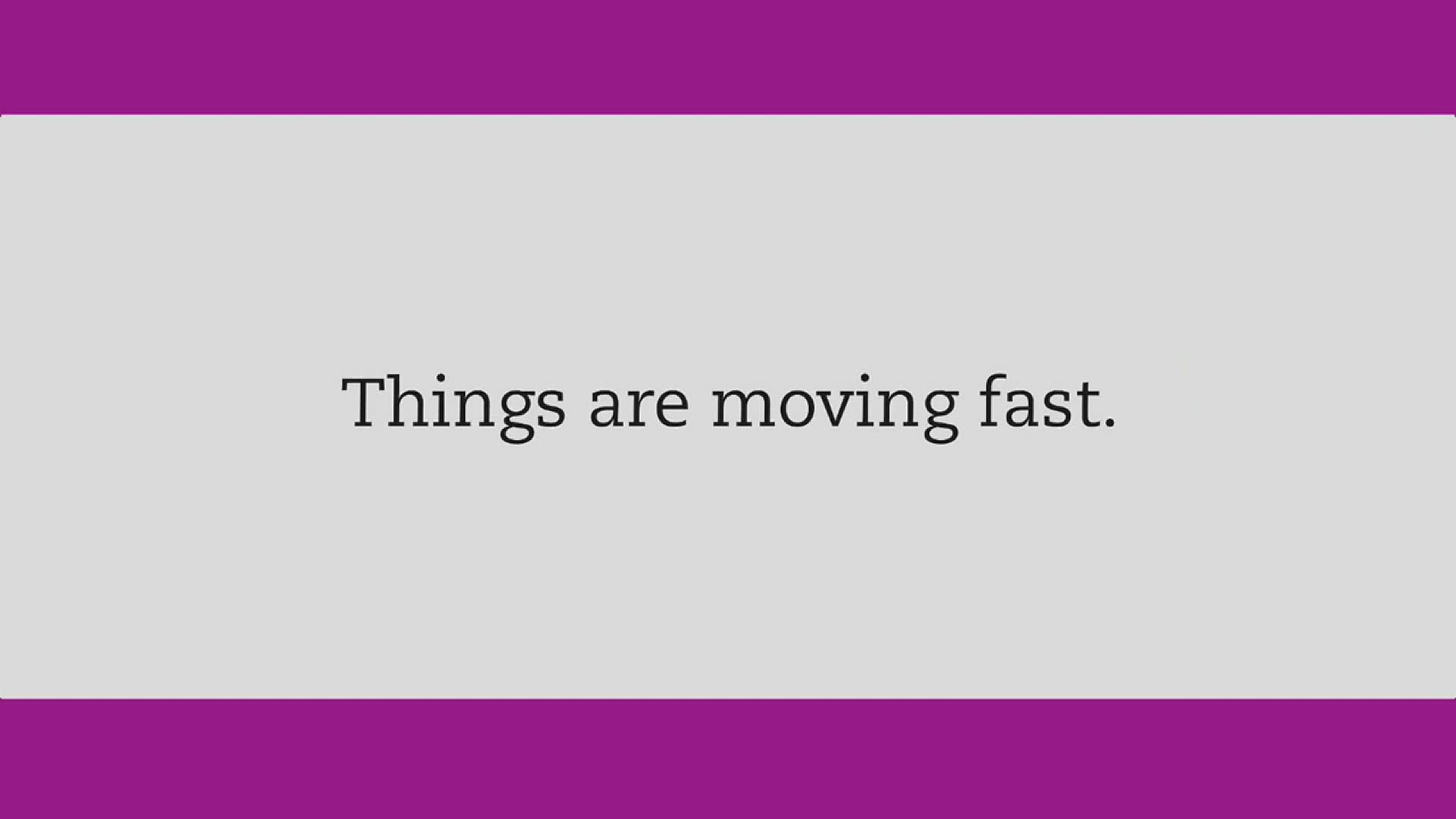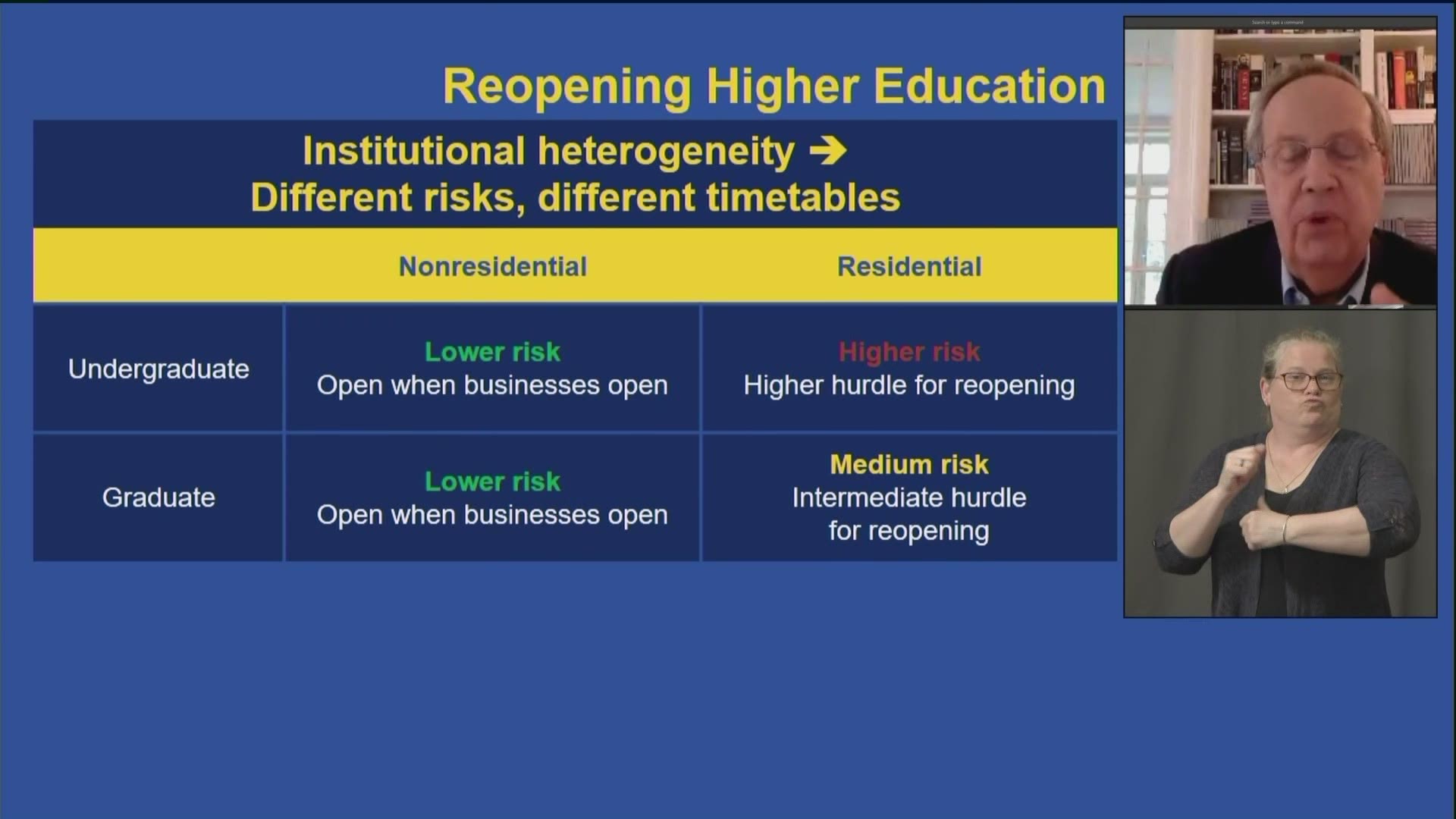HARTFORD, Conn. — Governor Ned Lamont and leaders from colleges and universities in the state are hopeful they will be able to reopen to students in the fall, but there are benchmarks that need to be met, and work that needs to be done for that to happen.
On Wednesday, the state revealed a detailed report containing recommendations for reopening. In the report, each higher education institution will be required to file specific plans with the state in order to reopen.
Those plans are expected to include:
- A plan for repopulation of the campus
- A plan for monitoring health conditions to detect infection
- A plan for containment to prevent spread of the disease when detected
- A plan for shutdown if it becomes necessary
Officials also revealed their recommendations for a phased-opening of colleges and universities over the next few months. The first part is phase 1a, which could begin on May 20th. It would allow research programs to reopen. In phase 1b, which aims to begin at the beginning of June, there is a focus on the nonresidential workforce and degree completion programs.
"There are a number of students who this Spring were caught in these types of programs and had to continue their classroom-based instruction online but were not able to complete their work in the shops or in clinical settings which are often very low density," said Linda Lorimer, a member of the Reopen Connecticut Advisory group. "So we want those students to be able to complete what they're doing now and also important workforce development programs that are nonresidential to get up and started as soon as institutions think they can after the beginning of June."
Phase 2 is set for the months of July and August. It focuses on other nonresidential programs and graduate programs.
Lorimer, who is also the former vice president for global and strategic initiatives at Yale University, said they've also been in contact with several institutions, which may look at creating undergraduate residential small-scale pilot programs.
"Imagine like the second half of a summer school in which they could kind of perfect what the guidelines might be for the implementation of larger residential settings come the fall," Lorimer said.
Phase 3 is set for September 1, 2020, which is the traditional time for colleges and universities to return.
"We think that it could be ready, again with the prevailing health situations improving and with the gating conditions met," Lorimer said.
According to Rick Levin, a member of the Reopen Connecticut Advisory group and the former president of Yale University, the gating conditions are criteria that must be in place to reopen safely. They include:
- Steady decline in hospitalizations
- Adequate number of tests available
- Capacity for contact tracing
- Statewide guidelines on physical distancing, density and wearing of facemasks
- Adequate PPE and facemasks
- Adequate hospital/health car surge capacity
- A limited safe harbor from liability
"One thing that must be kept in mind is this situation is fluid. We don't know today whether the gating conditions will be met in time for a full reopening of campuses in the fall. In particular, we don't know if prevailing health conditions will stay safe enough to warrant reopening. If there's a rise of hospitalizations in the summer, any kind of second wave - the governor may declare the phases have to be delayed and reopening will not be possible."
Levin said schools need to be flexible, and ready to open in the fall, but they also need to be ready to move online if absolutely necessary. He added that each institution is different and that will be taken into consideration.
"Institutions around our state differ considerably in the populations that they serve and the mode of delivery," Levin said. "There are undergraduate and graduate students who differ primarily in age."
He went on to say undergraduates learning in nonresidential settings may be at lower risk, while undergraduates learning in residential settings are at higher risk.
"People come into a community college or some of our nonresidential private institutions and take their class or two and go home. They're encountering people just as you would in a retail store or in an office, but if social distancing is maintained in those spaces, we think it's reasonably safe to think of those institutions like we think of businesses and have them start to open as the various business sectors open. Residential education poses a much higher risk because we have students living together 24/7," Levin said.
According to Mark Ojakian, the president of Connecticut State Colleges and Universities, the plan relies heavily on public health experts.
"We need to make sure all of the guidelines are adhered to before we will be comfortable welcoming students, faculty and staff back to our schools," Ojakian said. "We will not move forward until all the conditions have been met, and we can give reasonable assurances to faculty, staff, students and their families that we are in a position to reopen up.”
Ojakian added that this plan is not a one-size-fits all.
"We're all very different, we serve different students, we're in very different geographic areas, but the one consistent theme will be - we not reopen until we have reasonable assurance that all our of our campus community will come back to school and be healthy and safe," Ojakian said.
Officials explained what campuses and learning could look like in the fall, including 6-feet of separation wherever possible. That would include in classrooms, dining halls and where students congregate. They added larger classes may need to split into sections if possible and some classes could also become hybrids with in-class learning and virtual learning.
"We have different kinds of institutions. The residential institutions and liberal arts institutions like Trinity College are going to try to have face-to-face instruction when possible because we think that is the best way to teach - to deliver the type of education that we offer. So I think that's why I love this plan because it understands that different institutions may come to slightly different solutions," said Joanne Berger-Sweeney, President of Trinity College.
When asked by FOX61's Zinnia Maldonado on their message to parents of prospective students worried about sending freshmen to these schools in the fall, Ojakian replied, "We're not going to reopen our campuses until there are adequate assurances that all the public safety guidelines have been met at a minimum. Many of us may decide to issue stricter guidelines depending on our student demographics and where we're located. So I would say if we're going to be open to great students, we're going to be the healthiest and safest places to go. I view this as a positive to say we will be open for business, we will be open to great students and their families and while everyone is going to be anxious in starting a normal existence again, we will be ready and we will have met the public health guidelines."


